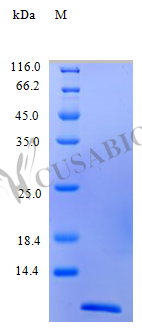This recombinant human CCL13 protein is expressed in E. coli and contains an amino acid sequence corresponding to the region 24-98aa of the human CCL13 protein. The product is tag-free and provided as a lyophilized powder, which can be reconstituted in sterile water or buffer before use. The purity of the protein is >96%, as determined by SDS-PAGE and HPLC, and the endotoxin level is less than 1.0 EU/µg, as measured by the LAL method. The recombinant CCL13 is fully biologically active when compared to the standard, and its activity has been determined by a chemotaxis bioassay using human monocytes at a concentration of 10-100 ng/ml.
C-C motif chemokine 13 (CCL13) is a small secreted protein belonging to the CC chemokine family. It is involved in the recruitment and activation of immune cells, particularly monocytes, and plays a crucial role in immune and inflammatory responses. Research in the area of immunology has been focused on understanding the function and regulation of CCL13 and its role in various immune-mediated diseases.






